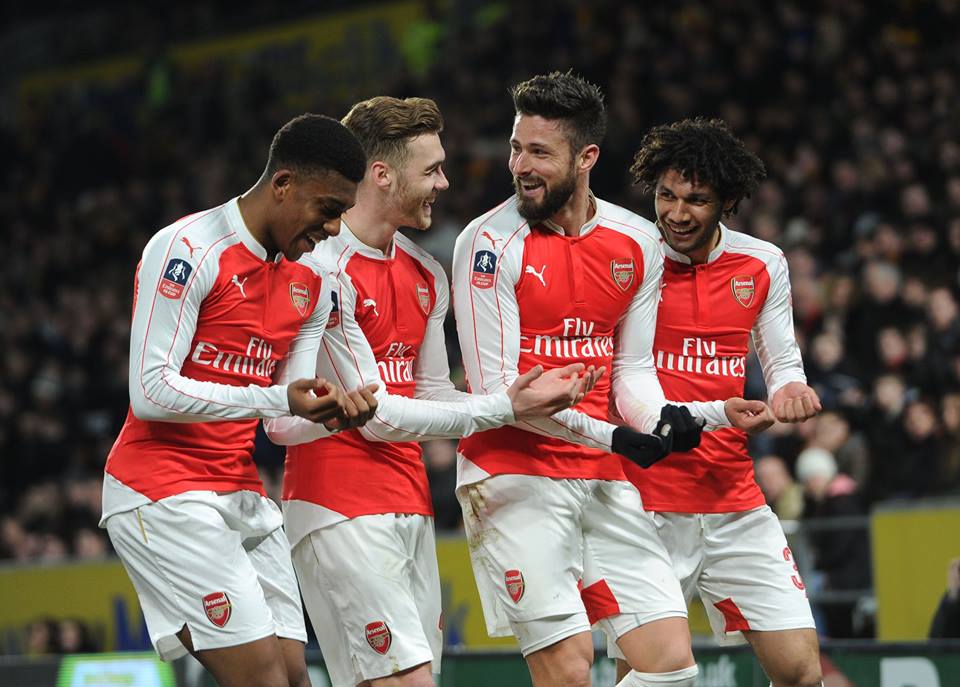Arsenal FC | Midfield merry-go-round and the barren Emirates

Image Courtesy: © Facebook - Arsenal FC
When Arsenal finished the season with an initially nervy but eventually comfortable 4-0 win over Aston Villa and pipped Spurs to second, the mood was decidedly chirpy around Emirates Stadium. But underneath the manufactured cheer of the laps of appreciation and ‘Ya gunners ya’, there lies a concern of frustratingly goal-shy underperformance at home. Arsenal have been found wanting at Ashburton Grove far too often this season, a deficit stemming from a confluence of factors that will need addressing if the Gunners are to improve on their showing next season.
Let us try to dissect Arsenal’s parsimony at home:
Midfield Merry-Go-Round
One of the chief harbingers of Arsenal’s positive form at the tail end of the 2014-15 season was the newfound midfield partnership of Santi Cazorla and Francis Coquelin. The pixie-footed Spaniard brought the guile and glamour, while the snarl-faced Frenchman brought the bile and bullet. With this duo as the bedrock upon which gameplay was built, Arsenal finished that season very strongly, climbing up to third and winning a second consecutive FA Cup.
The midfield story of this season is nowhere as happy-sounding for Wenger’s men. Through a mix of injuries, loss of form, and incompatible playing styles, Arsenal have lacked a mainstay central midfield pair to dictate play and build a rapport. Take the season opener at the Emirates against West Ham, for instance. A central pair of Ramsey and Coquelin was tried out, the balance was all askew, and young Reese Oxford bossed the Arsenal midfield as West Ham ran out 2-0 winners.
Coquelin and Cazorla oversaw an effective but not exactly goal-heavy run of home games till October, when both fell prey to long-term injuries. A cello-taped patchwork of Flamini, Ramsey, and an inanimate carbon rod somehow saw Arsenal through Christmas. After their usual spring existential crisis, the Gunners ended the season with a rotating midfield of Elneny, Coquelin, Ramsey, and Cazorla. No pairing got an extended run-out, no pairing could establish a chemistry that comes with extensive co-play, and Arsenal looked forever like a team on the cusp of finding their feet as a result.

Arsenal used a total of six different midfield pairings in home league games all season. On the other hand, Leicester have gone only six league games without the central pairing of Drinkwater and Kante.
This unfinished quest of finding the right midfield base proved much costlier at home, where teams usually set out to play deep against the Gunners, pack their midfield, and hit the hosts on the break. The home team’s midfield has to be quick, incisive, and intuitively connected in these situations, synaptically firing off passes from muscle memory to open stubborn defences up. Arsenal, however, were more quicksand than quick, more lateral than incisive, and could rarely sustain periods of pressure to break down that metaphorical bus. This was painfully evident in the home defeats to Swansea and Chelsea, the draws against Crystal Palace and Tottenham, and eked out wins against Stoke, Norwich, Newcastle, and Bournemouth.
Even when the midfield did click, Arsenal’s misfiring attack contrived to miss the barn doors with banjos and compound the problem.
Attacking Breadcrumbs
Everyone including Arsene Wenger knew that Arsenal had a striker-shaped hole in their squad before the season started. But a failed pursuit of Benzema and an unwillingness to gamble ala Welbeck meant that the Gunners entered August with only Olivier Giroud as a recognized centre forward. As it usually goes with Arsenal seasons, things looked rosy initially. Theo Walcott started a few games up front and looked dangerous, constantly on the shoulder of the last defender and ready for balls in behind. Giroud was reduced to an option off the bench, but he wore that tag effectively, coming on to score goals and put games to rest. Then, again as it usually goes with Arsenal seasons, things started going askew.
After a few encouraging performances, Walcott got injured in the league cup against Sheffield Wednesday and never looked the same player once he returned. His shooting and finishing, which are mediocre at the best of times, plumbed to new depths. His energy, bite, and attitude also took a turn for the worse, perfectly encapsulated by the insipid pull out from a tackle against Sunderland.

Giroud battled bravely in his defense, but the flood-and-drought nature of his scoring coupled with the fact that he was made to play a gruelling stretch of matches without rest meant that he was always going to hit a rough patch. Between a brace against Liverpool in January and a goal against Man City in May, Giroud huffed, puffed, but pulled up short in front of goal in the league: a significant period to go without scoring when the team is relying on you to spearhead the title push.
Stat Attack
A comparison of Arsenal’s attacking statistics in home and away games reveal a telling story. A huge hat-tip to 7amkickoff from Arseblog News for these numbers:
| Arsenal's home no-show | Home | Away |
| Shots per game | 17 | 13.6 |
| Shots on goal per game | 6 | 5.2 |
| Goal's per game | 1.5 | 1.7 |
| Conversion % | 8.8 | 12 |
| % of shots on goal scored from | 25 | 31 |
While Arsenal take more shots and shots on target per game in home matches, their per-game goal count is higher on the road. Both standard conversion rates and a percentage of shots on target scored from, point towards the deficit in efficiency that Arsenal have in front of goal at the Emirates.
These stats can be explained by the opposition tactics used during Arsenal’s home games, which has already been discussed above. A proclivity to hunker down in front of goal, deny Arsenal space, and get men behind the ball means that the shots Arsenal have at home, while greater in number, may not be as clear-cut or statistically likely to result in goals as the shots they have away from home.
But it’s not all a function of the opposition. The numbers also speak of a general lack of attacking efficiency from Arsenal’s frontmen. Let’s put Olivier Giroud under the scanner again, this time with data:
| Olivier Giroud's profligacy | Home | Away |
| Shots | 62 | 33 |
| Goals | 4 | 8 |
| Conversion % | 6 | 24 |
As of the first week of May, the gulf between Giroud’s efficiency in home and away games was a wide one. While he scored 8 goals from 33 shots at an impressive conversion rate of 24% away from home, his figures at home are paltry enough to make one go red in the face. A mere 4 goals from 62 attempted shots with a shocking conversion rate of 6% highlights that teams are often able to shackle Giroud when Arsenal play at home. If we take headed goals out of the equation, the reading is even more sombre. Three out of four home goals have been headers for Giroud, which means he has scored only one non-headed home goal from 35 attempted shots – this translates to a conversion rate of 3%.
In summation, deficiencies in both midfield and attack have played a part in Arsenal’s poor goal-scoring form at home this season. With Elneny and Xhaka already purchased in midfield, and rumours swirling around about Janssen, Morata, and Vardy in attack, Arsene Wenger seems well aware of both these issues. Arsenal fans will hope for a swift conclusion to transfer business so that the coaching staff can focus on re-drilling this team and make the Emirates the sanctum of free-flowing goals that it once was.
Images Courtesy: © Facebook - Arsenal FC
-----------------------------------------------------------------------------------------------------------------------------------------------------------------------------------------------------------------------------------------------------------------------------------------
You can help Slum Soccer send 20 of our most talented footballers to represent INDIA at Homeless World Cup at Glasgow. Click here to know more.
